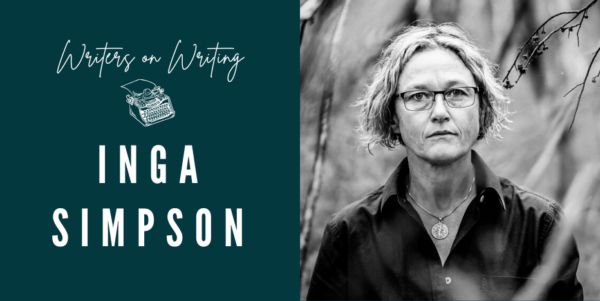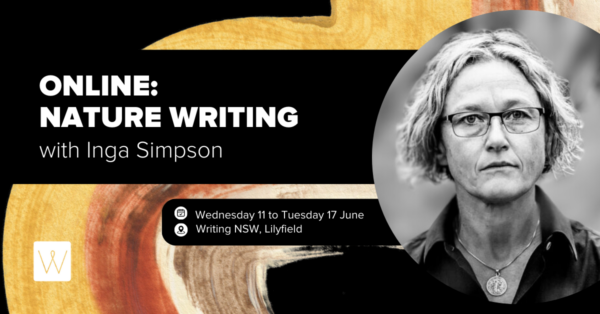

Writers on Writing is our regular conversation with a writer or industry professional about the writing craft, industry insights, and their own practice. This week, we spoke to Inga Simpson about why nature inspires her to write, and how writers can bring landscapes, flora, and fauna to life.
You’ve written both fiction and non-fiction, with strong ties to nature in both. Do you find the process of writing nature into your work easier for either of these genres?
All my writing seems to come from my connection to nature. Nature seems to write itself in – it’s the human story that I have to work at! Non-fiction, particularly nature writing, is easier in some ways. It’s just an extension of how I live my life – close to nature and paying attention.
I keep a nature diary, which includes my reflections – like a daily practice. I’m always doing that in my head. But I do feel the shadow of the great nature writers I admire; knowing that I don’t measure up. And I can get bogged down trying to capture all the details right in front of me accurately. There’s a freedom to writing fiction. Things emerge more subconsciously, deeper truths. I need both, I think.
There is a long history of using nature in literature for emotional and aesthetic purposes (I’m thinking Mary Shelley, Herman Melville). Who/what are your influences when writing nature into your work?
I’ve always been drawn to books with a strong sense of place, and to authors who write about the natural world authentically, which stems from their own deep experience. From childhood, Jean Craighead George’s My Side of the Mountain and Tolkien’s Lord of the Rings were major influences, as well as Australian classics like Blinky Bill (Dorothy Wall), The Nargun and the Stars (Patricia Wrightson) and Storm Boy (Colin Thiele). Melville’s Moby Dick and Jack London’s Call of the Wild were really significant to me, and to an emerging desire to write.
I studied Australian literature at university and was always most interested in writing the landscape. Tim Winton, and Gillian Mears, who I wrote a thesis on, influenced my own writing voice. But it has been nature writing that has had the biggest impact, and its ecological focus. Writers like Rick Bass, Annie Dillard, Barry Lopez, John Muir, Mark Tredinnick, Eric Rolls, Kim Mahood, Kathleen Jamie, and the poetry of Mary Oliver, who I’m pretty sure was some sort of angel.
Trees seem to feature quite strongly across your work – is this your own preference or is there something about trees that makes them great to write about?
I probably can’t help that! Trees are how I see the world and central to my imagination. I feel better when I’m among them. And my language seems to lend itself to writing about trees. A combination of how I grew up and what I read, and then making a tree change in my mid-thirties. My book, Understory: a life with trees (2017), tries to make sense of that.
Practically, trees are a good indicator of the type of country you’re describing and they are full of life: birds, mammals, reptiles and insects. Trees seem so still but they are actually pumping nutrients around, converting sunlight and sugars to energy, carbon dioxide to oxygen, growing, flowering, producing leaves, shedding bark, and communicating with each other. There is something magical about trees that are hundreds of years old – a gnarly old man banksia or a towering mountain ash – they have absorbed so much. Trees are sentient beings to me, a way of connecting with a world much larger and more enduring than my own.
Your new novel, The Thinning, is a thriller that grapples with ecological disaster. How does nature contribute to thrillers?
For me the natural world grounds the action and provides relief from the tension, a bit like the setting in crime novels. In The Thinning, the natural world is where Fin is comfortable and confident, where she finds calm amid the chaos. I’m hoping that is part of the reader’s experience, too.
In eco-thrillers and cli-fi, nature, is of course, central to plot and character. It is our survival, and the future of the planet, that the protagonists are fighting for! In the near-and-likely future of The Thinning, there is a natural balance that needs to be restored. It’s a race against time, but Fin’s deep knowledge of her local environment is key.
I think survival – in fiction and reality – will depend not on technology, but our relationship with the landscapes and other beings around us. The beauty of fiction is that we can reimagine a future other than the one we seem to be rushing towards.
Dr Inga Simpson is a New South Wales writer whose work, across multiple genres, focusses on our relationship with the natural world. Her latest dystopian novel, The Thinning, was longlisted for the 2024 Indie Book Award for fiction, while her previous novel, Willowman, about the art of cricket bat making, was voted one of BookPeople’s 100 Must-Read Australian Novels.
Inga’s earlier novels – Mr Wigg, Nest, Where the Trees Were and The Last Woman in the World – have all been long and shortlisted for numerous awards, including the Miles Franklin Literary Award and the Stella Prize. Her first book-length work of nature writing, Understory: a life with trees (Hachette: 2017), was shortlisted for the Adelaide Writers Week prize for nonfiction.
Inga has PhDs in creative writing and English literature, with her most recent thesis exploring the history of Australian nature writing. Her essays and short stories have been published in Griffith Review, Wonderground, Chicago Quarterly Review, Openbook, Review of Australian Fiction, Clues, Writing Queensland, and The Dictionary of Literary Biography. She was also the winner of the (final) Eric Rolls nature writing prize for her essay “Triangulation.”
Inga lives on the far south coast. She is currently working on a collection of short stories and a non-fiction book about her favourite Australian trees. Her picture book, The Peach King, illustrated by Tannya Harricks, will be released in October 2025.
Join Inga Simpson for Online: Nature Writing, Wednesday 11 to Tuesday 17 June 2025, online.

If you want to be the first to read great advice, prompts and inspiration from our incredible tutors, subscribe to our weekly e-newsletter Newsbite.
More from Writing NSW
Check out our full range of writing courses in Sydney, our online writing courses and our feedback programs to see how we can help you on your creative writing journey. Find out about our grants and prizes, as well as writing groups across NSW, and sign up to our weekly newsletter for writing events, opportunities and giveaways.
